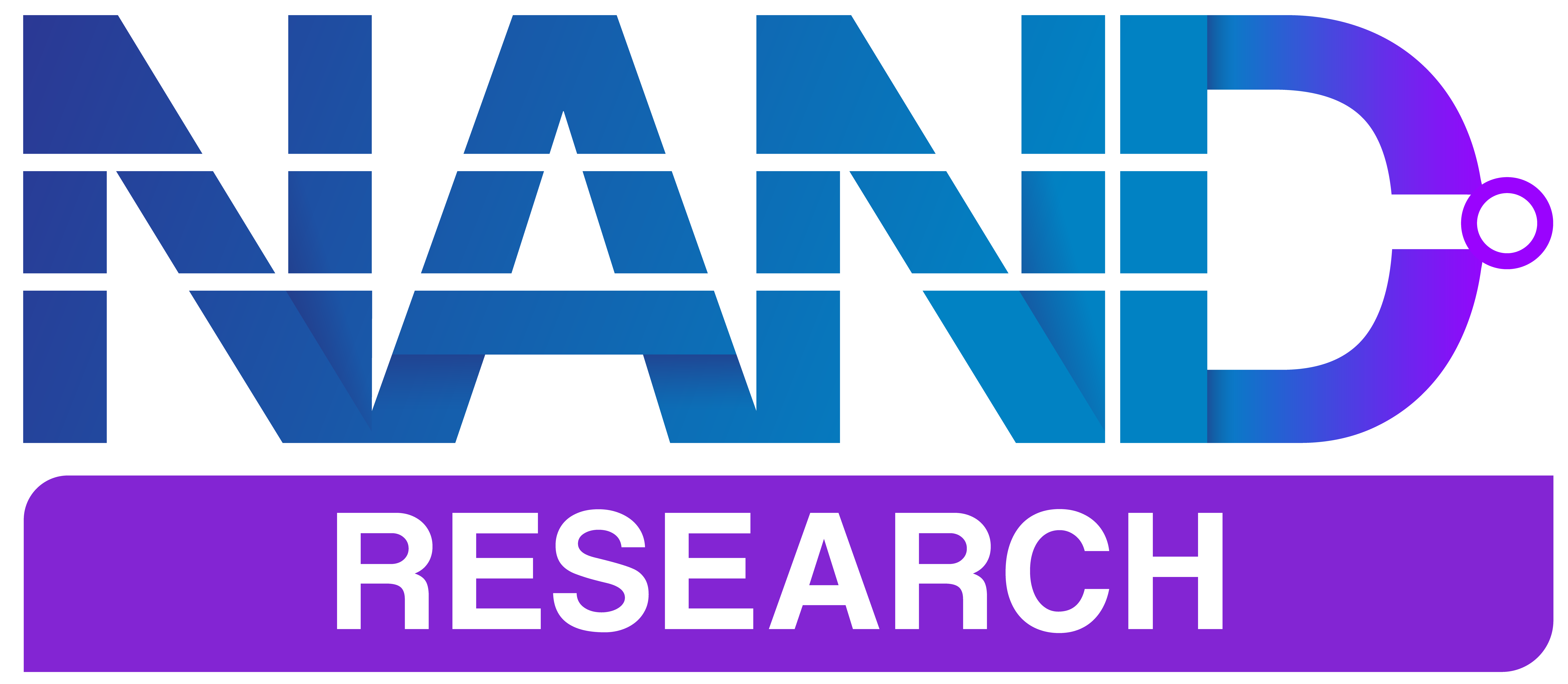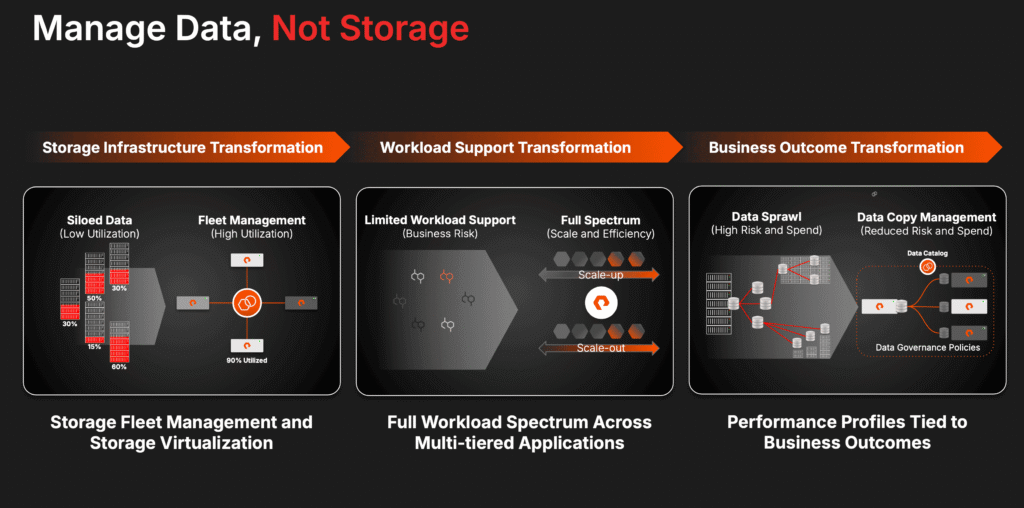At its recent Pure //Accelerate event, Pure Storage introduced its new Enterprise Data Cloud (EDC) architecture, positioning the concept as a unified data management platform that consolidates storage operations across hybrid environments.
The EDC centers on Pure Fusion, the company’s storage orchestration layer, with new automation capabilities, including workload presets, workflow orchestration, and enhanced security integrations.
Key technical additions include VMware-to-VMware recovery in Pure Protect, CrowdStrike LogScale integration for log analytics, and a partnership with Rubrik Security Cloud for cyber recovery automation. The AI Copilot reaches general availability, providing fleet-wide operational insights.
With this announcement, Pure hopes to address enterprise challenges of storage fragmentation, manual provisioning workflows, and limited visibility across hybrid deployments.
Technical OVerview
Pure Storage’s Enterprise Data Cloud shifts from traditional storage array management to a software-defined platform that abstracts storage resources into a unified, policy-driven service layer. Its technical foundation rests on three core pillars: centralized orchestration through Pure Fusion, automated workload provisioning, and cross-platform workflow integration.
The EDC addresses several technical challenges that have historically plagued enterprise storage environments: the complexity of managing heterogeneous storage arrays, the manual overhead of provisioning and configuration management, and the operational friction of maintaining consistent policies across hybrid deployments. By virtualizing storage resources into a centralized control plane, the EDC platform enables organizations to treat their entire storage estate as a single, programmable resource pool.
Core Architecture Components
The foundational element of the EDC platform is Pure Fusion, which serves as the central orchestration engine for all storage operations. This control plane architecture abstracts individual array management into fleet-wide operations, allowing for seamless management across the entire fleet.
Rather than managing arrays as discrete systems, Pure Fusion enables administrators to define intent-based policies that automatically execute across the entire storage estate.
This approach leverages software-defined principles where storage resources become programmable through a comprehensive API layer. It’s an abstraction that enables the platform to make intelligent decisions about resource allocation, performance optimization, and capacity management without requiring manual intervention from storage administrators.
The system maintains awareness of the entire fleet topology, performance characteristics, and capacity utilization, enabling automated decision-making that optimizes resource utilization across the environment.
Pure Fusion delivers several core capabilities that differentiate it from traditional storage management approaches:
- Self-discoverable array management with automatic fleet discovery that eliminates manual configuration of storage endpoints
- Unified resource pooling across on-premises and cloud deployments, treating hybrid environments as a single resource tier
- Policy-driven provisioning with workload-specific presets that ensure consistent security, performance, and compliance configurations.
- REST API framework for programmatic operations that enables integration with existing automation and orchestration platforms
Enhanced Workload Automation Capabilities
The platform’s workload automation capabilities address one of the most time-consuming aspects of storage management: provisioning and configuring storage resources to meet specific application requirements. Traditional storage provisioning typically requires extensive manual configuration, including LUN creation, zoning, masking, and performance tuning.
Pure Storage’s automation framework streamlines this process by providing template-driven provisioning that automatically configures storage resources according to workload requirements.
The system utilizes machine learning algorithms to optimize configuration parameters based on historical performance data and workload patterns, thereby reducing the need for manual tuning and ensuring consistent performance across all deployments.
Pure’s workload automation enhancements include several key capabilities:
- Pre-configured templates for file, block, and object storage that incorporate best-practice configurations for common use cases
- Remote provisioning capabilities across distributed arrays that enable centralized management of geographically dispersed storage infrastructure
- Automated performance optimization that adjusts resource allocation based on workload characteristics and utilization patterns
- Reduced manual configuration requirements for deployment consistency, minimizing human error and accelerating deployment timelines
Comprehensive Workflow Orchestration Platform
The workflow orchestration capabilities in Pure EDC enables IT teams to automate complex, multi-step processes that span storage, compute, network, and application layers.
This orchestration framework addresses the challenge of coordinating activities across disparate systems and tools, which typically requires custom scripting and manual coordination between different administrative teams.
The platform’s orchestration engine offers a visual workflow designer, enabling administrators to create sophisticated automation workflows without requiring extensive programming knowledge.
These workflows can incorporate conditional logic, error handling, and rollback capabilities, ensuring the reliable execution of complex processes. The system maintains audit trails of all orchestrated activities, providing visibility into automated processes and supporting compliance requirements.
The workflow orchestration capabilities include:
- Integration connectors for Cisco, Microsoft, VMware, ServiceNow, and Slack that enable seamless data exchange and process coordination
- Pre-built application “recipes” for infrastructure automation that codify best practices for common deployment scenarios
- Custom workflow development capabilities that allow organizations to create specialized automation for unique requirements
- Cross-platform orchestration spanning storage, compute, network, and database layers, enabling end-to-end automation of complex infrastructure operations.
Advanced Security and Recovery Capabilities
The security and recovery framework evolves how enterprises approach data protection and cyber resilience within their storage infrastructure. Traditional backup and recovery solutions typically operate as separate systems with distinct management interfaces, recovery procedures, and policy frameworks.
This fragmentation creates operational complexity and potential security gaps, particularly in the face of sophisticated ransomware attacks that target backup systems alongside primary storage.
Pure Storage’s integrated approach embeds security and recovery capabilities directly into the storage fabric, creating a unified defense mechanism that spans the entire data lifecycle. The platform’s security architecture leverages immutable snapshot technology, automated threat detection, and coordinated response capabilities to provide comprehensive protection against both internal and external threats.
Pure’s integrated approach significantly reduces the attack surface by eliminating the need for separate backup appliances and associated network connections.
The platform’s cyber recovery capabilities extend beyond traditional backup and restore functionality to include automated threat response, forensic analysis support, and business continuity orchestration.
By integrating with leading security platforms, the system can automatically respond to detected threats by isolating affected systems, creating forensic snapshots, and initiating recovery procedures without requiring manual intervention.
Pure announced several integrations as part of its EDC launch:
A new Rubrik Security Cloud Integration provides comprehensive cyber recovery automation:
- Automated tagging of SafeMode snapshots during threat detection that ensures recovery points remain uncompromised during security incidents
- Ransomware scanning integration with backup validation that automatically verifies the integrity of backup data before restoration
- Granular recovery options with secondary restore paths that enable surgical recovery of specific files or databases without full system restoration
- Near-zero RTO targets through automated recovery workflows that minimize business disruption during security incidents
The CrowdStrike LogScale Partnership delivers optimized security analytics capabilities:
- Validated on-premises storage configuration for Falcon LogScale that ensures optimal performance for security log analysis and threat hunting
- Optimized performance for log analytics and threat-hunting workloads with specialized storage configurations that maximize query performance
- Self-hosted deployment model maintaining organizational control over sensitive security data and analysis processes
- Scalable architecture for high-volume log ingestion that supports enterprise-scale security monitoring and compliance requirements
Pure Protect VMware Recovery extends disaster recovery capabilities:
- VMware-to-VMware recovery capabilities added to existing AWS recovery options, providing flexibility in recovery target selection
- On-demand recovery testing and flexible failover configurations that enable regular validation of disaster recovery procedures
- Self-service disaster recovery assessments that empower application teams to validate their recovery capabilities independently
- Hybrid environment support for business continuity planning that ensures consistent recovery capabilities across on-premises and cloud deployments
Operational Intelligence and Analytics
The Enterprise Data Cloud’s operational intelligence capabilities address the challenge of maintaining visibility and control across increasingly complex storage environments. Traditional storage monitoring relies on reactive alerting systems that notify administrators after problems have already impacted applications or users.
The EDC platform’s approach leverages artificial intelligence and machine learning to provide predictive insights, automated optimization, and proactive issue resolution.
The AI-powered analytics engine continuously analyzes performance patterns, capacity utilization, and system health indicators across the entire storage fleet. This analysis enables the system to identify potential issues before they impact applications, automatically optimize resource allocation based on changing workload demands, and provide actionable recommendations for capacity planning and performance tuning.
The system’s learning algorithms improve over time, becoming more accurate in their predictions and recommendations as they accumulate more data about the environment’s behavior patterns.
Analysis
The ongoing AI revolution is driving a fundamental architectural shift in enterprise storage, transitioning from traditional storage-centric approaches toward data-centric infrastructure platforms that accommodate the complex, multi-variate requirements of AI workloads and advanced analytics.
This transformation demands a storage infrastructure that can dynamically adapt to fluctuating data access patterns, support massive parallel processing requirements, and deliver the low-latency performance characteristics essential for machine learning operations.
Pure Storage is responding well to these needs, with its Enterprise Data Cloud elevating the company from its traditional storage roots into a provider of a comprehensive approach to modernizing storage operations through centralized management, automated workflows, and integrated security capabilities. Pure’s EDC addresses legitimate enterprise challenges around storage fragmentation, operational complexity, and hybrid cloud management.
The technical capabilities, particularly Pure Fusion’s orchestration features and security integrations, provide tangible benefits for IT teams struggling with manual storage administration and siloed management tools. The Evergreen architecture continues to differentiate Pure Storage in the market by eliminating disruptive refresh cycles.
The comprehensive nature of the Enterprise Data Cloud platform, combined with the company’s proven ability to deliver on architectural vision through products like Evergreen, keeps Pure Storage well-positioned to compete effectively for this data-centric future.
Competitive Outlook & Advice to IT Buyers
While virtually every storage vendor acknowledges the shift AI is driving and is to adapt their respective offerings accordingly, Pure Storage is among the most aggressive in the mainstream traditional storage market, evolving its platform to meet these emerging requirements.
At the same time, up-start innovators like WEKA, with its recently announced NeuralMesh architecture and token-window-focused Augmented Memory Grid, and VAST Data, which is taking a hyper-converged approach with its new AI OS, offer more radical approaches.
Landing on the correct answer can be challenging.
These sections are only available to NAND Research clients and IT Advisory Members. Please reach out to [email protected] to learn more.





